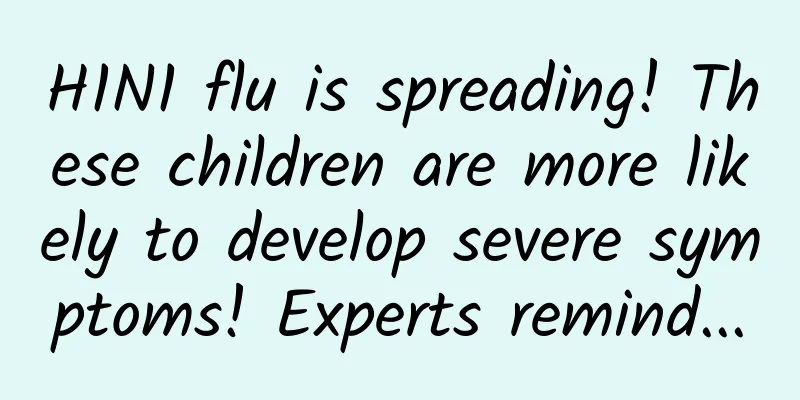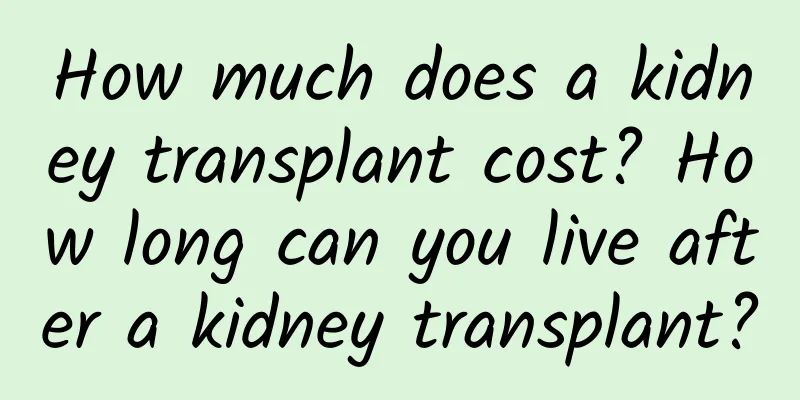H1N1 flu is spreading! These children are more likely to develop severe symptoms! Experts remind...

|
With the recent significant increase in influenza A (H1N1) cases, parents are beginning to be concerned about the impact of H1N1 on their children. Although H1N1 is a respiratory disease caused by the influenza A virus, the symptoms, treatments, and complications can differ significantly between children and adults. Let's learn about the epidemic characteristics of influenza A in children, as well as some differences between influenza A in children and adults, so that parents can better understand and correctly respond to this epidemic. Epidemic characteristics of influenza A in children High season In the north and south of my country, seasonal influenza usually occurs in winter and spring, and in some areas of the south, it often occurs in summer. By paying attention to the weekly influenza monitoring report of the Chinese Center for Disease Control and Prevention, you can understand the current influenza epidemic situation. Sources of infection and routes of transmission Influenza patients and asymptomatic infected persons are the main sources of infection of seasonal influenza. Mode of transmission: Influenza viruses are mainly transmitted through respiratory droplets produced by sneezing, coughing, etc. of infected people. In addition, it can also be transmitted through direct or indirect contact with the mucous membranes of the mouth, nose, eyes, etc. Aerosol transmission may also occur in closed or poorly ventilated places when there are dense crowds of people. Copyright images in the gallery. Reprinting and using them may lead to copyright disputes. Incubation period and infectiousness Incubation period: usually 1 to 4 days (average 2 days). Infectious period: The infected person is contagious from the end of the incubation period to the acute phase. The virus can be discharged 24 to 48 hours before the onset of clinical symptoms, and the highest amount of virus is discharged within 24 hours after the onset of the disease. Detoxification duration: Adults and older children generally detoxify for 3 to 8 days (average 5 days). Young children detoxify for a longer time, especially infants and young children, who can often detoxify for 1 to 3 weeks. Characteristics of children's communication Children are the main source of influenza virus transmission, often spreading the virus to family members or bringing it into childcare institutions, schools and communities. It is recommended that influenza patients avoid contact with high-risk groups for influenza (people aged <5 or ≥65 years, pregnant women or those 2 weeks postpartum, and immunocompromised people with underlying diseases) until 7 days after onset of illness and 24 hours after fever subsides. Differences between flu symptoms in children and adults Effects and complications of influenza in children Influenza in children can significantly increase the frequency of outpatient visits, hospitalizations, and antibiotic use, while causing school-age children to miss school and parents to miss work. Although most children can recover on their own, some may develop serious complications. According to foreign statistical studies, common complications of influenza in children include: Otitis media The most common complication, especially in children under 2 years old. Ear infections usually cause severe ear pain and hearing problems, with symptoms usually appearing on the 3rd to 4th day of onset, accounting for about 10% to 50% of children with influenza. pneumonia Influenza viruses can directly invade the lungs and cause viral pneumonia, or secondary bacterial pneumonia. It is more common in children with weakened immune system or underlying diseases (such as asthma and heart disease). Among children hospitalized with influenza, approximately 28% also had pneumonia. Asthma/wheezing attacks Influenza can trigger or aggravate asthma, accounting for approximately 22% of influenza-related hospitalizations in children. Febrile seizures Seizures occur during fever and account for about 5% of children hospitalized with influenza. respiratory failure It accounts for about 5% of children hospitalized for influenza and is one of the critical complications. Central nervous system diseases (except febrile seizures) Including encephalitis, encephalopathy, etc., accounting for about 2.9% of children hospitalized due to influenza. Severe bacterial infection The risk of developing a serious bacterial infection secondary to influenza is about 2%. Laryngitis and laryngo-tracheo-bronchitis Although rare (<1%), it is more severe than other viral causes of laryngitis and is prone to recurrence, with symptoms including hoarseness, a barking cough, and stridor. Encephalitis, myositis, and myocarditis Extremely rare (<0.1%), but serious. Symptoms include repeated convulsions, drowsiness or coma (encephalitis); extreme muscle tenderness (myositis); palpitations, shortness of breath, fatigue, etc. (myocarditis). Key points: Influenza vaccination can significantly reduce the incidence, complications and severe illness rates. How to diagnose influenza promptly 1. Early suspicion criteria: During the flu season, fever + one of the following conditions: ① Infant's fever: no other cause of fever can be found. ② Respiratory symptoms: Children aged ≥1 year have fever accompanied by obvious respiratory symptoms (cough, sore throat, nasal congestion, runny nose, shortness of breath). ③Severe lung diseases: such as pneumonia, asthma attacks or aggravations, accompanied by fever. ④ History of contact with influenza: fever and close contact with influenza or suspected cases within 7 days before onset of illness, and other diseases are excluded. 2. Diagnosis criteria: There are two types of tests commonly used to diagnose influenza: Antigen testing The most commonly used method is immunochromatography, which produces results in 15 to 30 minutes and has a sensitivity of 42% to 64%. A positive result can confirm infection, but a negative result cannot completely rule it out. Nucleic acid amplification testing High sensitivity (86% to 100%), results are available in 2 to 48 hours. A positive result confirms infection, while a negative result indicates a low likelihood of influenza. Note: Antibody testing is not recommended. It takes a certain amount of time for influenza antibody IgM to increase, and it cannot help with diagnosis in the early stages. Antibody IgG diagnosis requires two blood draws in the acute phase and the recovery phase, which is not helpful for early clinical diagnosis and treatment and is only used for research. Copyright images in the gallery. Reprinting and using them may lead to copyright disputes. Which children need aggressive treatment? 1. The following four categories of people (high-risk groups for influenza) are more likely to develop severe illness or complications. After being diagnosed or suspected of influenza, they need active treatment and do not need routine testing (unless the results affect treatment or other reasons) or delay treatment while waiting for the results: ①Age <5 years old, especially <2 years old. ② Children with underlying diseases (such as obesity, asthma, epilepsy, congenital heart disease, Kawasaki disease, conditions that affect immune function or long-term medication, etc.). ③ Severe influenza symptoms occur, such as poor spirits, high fever for >3 days, or complications. ④Children who will have close contact with the following groups: a. <5 years old or ≥65 years old; b. Pregnancy or within 2 weeks after childbirth; c. Children with underlying diseases, people living in nursing homes or those who need long-term care; d. The family has a large population and has not received influenza vaccination. 2. Low-risk people who do not fall into the above conditions can observe at home when suspected or confirmed to have influenza, and take protective measures to avoid infecting others, and most of them can recover on their own. If symptoms in low-risk groups do not improve for more than 2 to 3 days, or if there is a need to shorten the course of the disease due to work or study, medication treatment may also be considered. 3. Drug treatment options There are currently two main oral anti-influenza medications for children: ① Oseltamivir: Suitable for the entire population and severe influenza. Take orally twice a day, the course of treatment is 5 days or more (depending on the condition); the best effect is within 48 hours, but it is also effective after 48 hours. The main purpose of the 5-day course of treatment is to reduce the incidence of complications, not just to reduce fever. If the child is in a high-risk group, it is recommended to take the full course of treatment as prescribed by the doctor. ② Baloxavir: According to my country's guidelines and the recommendations of the US FDA, Mabaloxavir can be used to treat influenza in children over 5 years old. It only takes one oral dose, and its final effect in treating influenza A is equivalent to that of oseltamivir, and it has advantages over oseltamivir in treating influenza B. Suitable for mild to moderate influenza that is difficult to take medication in outpatient clinics. Internationally, the European Union has approved the use of this drug for children aged ≥1 year with influenza. Japan has approved the use of this drug for children weighing ≥10 kg with influenza. China also has research data on the safety and efficacy of the drug for children aged 1 to 5 years, but it should be noted that children under 5 years old are more likely to develop viruses resistant to mabaloxavir when using this drug, so parents and doctors are advised to choose with caution. Children exposed to influenza Do I need to take preventive medication? Post-exposure or pre-exposure prophylaxis is not routinely recommended. Preventive medication can be used for some children aged ≥ 3 months who are at very high risk of severe or complicated influenza (such as those with severe immunocompromise) or their close contacts. For people at high risk of influenza, preventive medication may be needed. It is recommended to discuss the pros and cons with your doctor: Increased risk of drug resistance; During the flu season, children may be exposed to flu patients many times, and continuous or repeated preventive medication is not feasible unless the doctor assesses that the risk of severe illness or complications is extremely high. Compared with preventive medication, it is recommended that high-risk groups with a history of contact with influenza receive timely treatment after symptoms appear. Summarize The impact of influenza A on children is more complicated than that on adults. In addition to common symptoms such as fever and cough, children are prone to complications such as pneumonia and febrile convulsions (see previous articles), which require parents to pay special attention. Correct early diagnosis (suspected diagnosis), early antiviral treatment, and timely identification of complications will help reduce the risk and promote recovery in children. Parents should pay attention to preventive measures during the flu season, such as washing hands frequently, wearing masks, and try to vaccinate their children against the flu to reduce the chance of infection. References [1] Pediatric Professional Committee of Chinese Medical Education Association, Respiratory Group of Pediatric Branch of Chinese Medical Association, Pediatric Respiratory Working Committee of Respiratory Physician Branch of Chinese Medical Doctor Association, etc. Guidelines for Diagnosis, Treatment and Prevention of Influenza in Children (2024 Doctor Edition) [J]. Chinese Journal of Practical Pediatrics, 2024, 39(12): 881-895. DOI: 10.3760/cma.j.cn101070-20241105-00719. [2] Chinese Medical Doctor Association Emergency Physician Branch, Chinese Medical Association Emergency Medicine Branch, Chinese Emergency Specialty Medical Association, etc. Emergency expert consensus on diagnosis and treatment of influenza in adults (2022 edition) [J]. Chinese Journal of Emergency Medicine, 2023, 32(1): 17-31. [3] Li Lanjuan, Wang Yuming. Infectious Diseases[M]. 3rd edition. Beijing: People's Medical Publishing House, 2015. [4] Flor M Munoz, Morven S Edwards. Seasonal influenza in children: clinical features and diagnosis. UpToDate Clinical Advisor. https://www.uptodate.com/contents/zh-Hans/seasonal-influenza-in-children-clinical-features-and-diagnosis. (Accessed on Aug 30, 2023). [5] FlorMMunoz, MorvenSEdwards. Management of seasonal influenza in children. UpToDate Clinical Advisor. https://www.uptodate.com/contents/zh-Hans/seasonal-influenza-in-children-management. (Accessed on Mar 27, 2024). [6] Flor M Munoz, Morven S Edwards. Seasonal influenza in children: prevention with antiviral drugs. UpToDate Clinical Advisor. https://www.uptodate.com/contents/zh-Hans/seasonal-influenza-in-children-prevention-with-antiviral-drugs. (Accessed on Nov 06, 2024). Planning and production Author: Fan Yunzhu Hangzhou Ho Yun Chia Hospital Nha Trang Clinic Reviewer: Li Dongzeng, Chief Physician, Department of Respiratory and Infectious Diseases, Beijing Youan Hospital |
<<: What should I do if Helicobacter pylori is found during a physical examination?
Recommend
A must-see for girls! ! ! What is the reason for delayed menstruation?
Menstruation is a normal physiological phenomenon...
Will I grow taller after my period?
When girls enter puberty, they will normally have...
My baby is not growing and is not getting enough nutrition. Should I make the milk powder more concentrated?
This statement is totally wrong. Deliberately inc...
"The tip of the tongue tastes sweet, the back of the tongue tastes bitter"? What you think is the tongue's "taste map" is actually fake
"The tip of the tongue tastes sweet, the bac...
How long does it take for menstruation to come after a miscarriage?
In fact, today's female friends are all worki...
How do women maintain their sexual appeal?
Sex, like life, will change over time from passio...
How many days can Enoki mushrooms be kept in the refrigerator? How to determine whether Enoki mushrooms are still edible?
Enoki mushrooms are soft and tender, and are deli...
The follicle is released before it matures
Female eggs are not always present like male sper...
Symptoms of female sexual indifference
Here are some signs of female sexual apathy. Many...
What are the advantages of painless fallopian tube dredging?
The main cause of infertility in many women is fa...
What to eat to replenish blood during menstruation, you can eat more of these 10 foods
There is a period of time every month when women ...
Can blood sampling during a physical examination lead to anemia? Finally figured it out!
An essential part of every physical examination i...
Causes of uneven endometrium
I believe everyone knows the important role of th...
2024 Medical Science Popularization - Ultrasound-guided Thyroid Nodule Ablation
[The principle of thyroid nodule ablation] is to ...
Great Ways to Reduce Menstrual Pain
Every month women will experience unbearable abdo...









